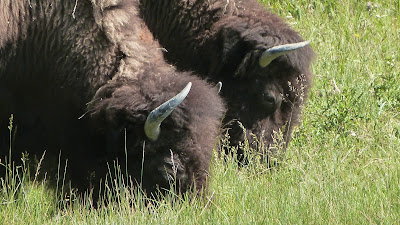No! Really! It's HUGE! There is no mistaking this guy for a "teenager." He is the real deal!
Thank goodness he was on one side of the river, and we were on the other!
The grizzly bear is officially named the
Ursus arctos horribilis. (What an appropriate name - even if it was an accidental naming. The guy that did the naming misunderstood what folks were telling him. Instead of "grizzly," he thought they meant "grisly," which means inspiring horror or intense fear.) This bear is more affectionately sometimes called a
silver tip. I've seen lots of photos of grizzly bear - but I honestly think our photos on this trip better show the grizzle, or silver tips, than any other photos I've ever seen. Maybe he'd just had a bath. Maybe it was the super bright sunlight. Regardless, I think we got some great photos!
These guys are apparently descended from Russian brown bears and came to North America across the land bridge to Alaska. (That's the only way I'll ever get to Europe - when they build a bridge from Alaska...) They hung out wa-a-a-a-y up north until about 13,000 years ago when they began to wander down into what is now the U.S.
I'm pretty sure this is a male because he hangs out by himself and lives in a man-cave. (Not really. Hangs out by himself, yes, but no on the man-cave part. I just couldn't resist...)

We tracked him for over an hour. I'm still totally amazed at that.
Even though there were the usual stupid tourists running down to the river to get better pictures, he didn't seem very perturbed.
You know, Yellowstone is closed to all but a very few folks (about 400 I
think) in the late fall and winter months. I used to think it was
because of the treacherous nature of snow and ice and minus 40
temperatures; now I believe it has something to do with the rutting
season of these wild animals, too. If we're too stupid to keep our distance
when these guys are in a good mood, we're probably too stupid to keep
our distance when the male buffalo, elk, and bear are hunting for a mate... I'd bet it's pretty loud and scary around these parts about then!
Females only have cubs every other year, sometimes as many as FOUR, and they only weigh about one pound each when they're born. Wild grizzlies can live up to thirty years!
Yellowstone is about as far south as you'll be finding a grizzly now. They used to be found all the way into Mexico. In fact, the California state flag sports the image of a grizzly bear, but they have been ecologically extinct there since the last one was shot in 1922. (So much for California conservationists...) How do you count how many grizzly bears there are? It's not as easy as counting their feet and dividing by four. Canadian authorities do it by "hair-snagging, DNA-based inventories, mark-recapture and a refined multiple regression model." I'm thinking counting feet and dividing by four would be so much easier...
In Yellowstone, a griz mostly eats berries, whitebark pine nuts, tubers, grasses, small rodents, army cutworm moths (yucko pooey pooey!), lady bugs, bees, ants and they will scavenge carcasses they happen across. Canadian grizzlies are usually bigger than ours because they get to feast on the salmon.
He just moseyed, and moseyed, and moseyed. We finally had to tear ourselves away. I mean, really, John,
seventy snapshots plus videos? (Golly I wish I could show them ALL to you guys! They are amazing. Granpa did good!) Bye-bye, Mr. Bear.
If
you're having trouble with the Comment feature, please feel free to use
our blog email
to
reach us.

















































